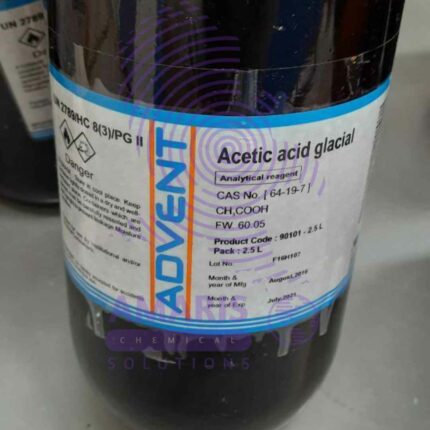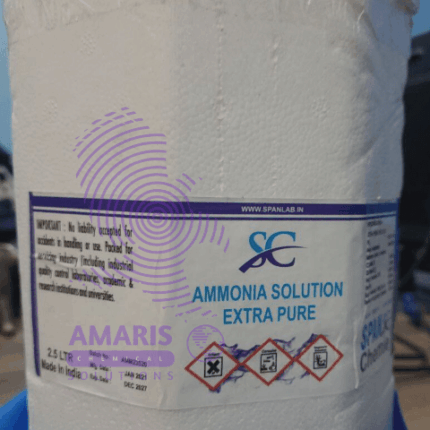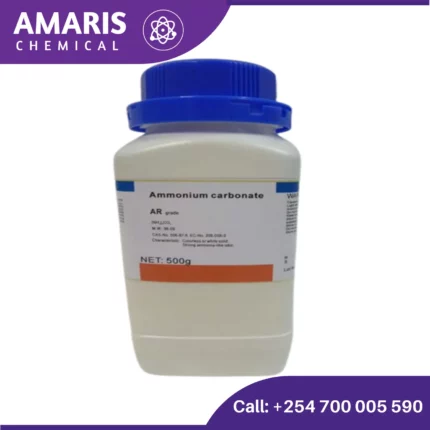
Acetic Acid 2.5litre
$1,490.00 Original price was: $1,490.00.$1,300.00Current price is: $1,300.00.

Aluminum Ammonium Sulphate
$650.00 Original price was: $650.00.$500.00Current price is: $500.00.
Aceto Carmine 100 ml
$1,745.00 Original price was: $1,745.00.$1,500.00Current price is: $1,500.00.
Whatsapp Order
Aceto carmine is a staining solution used primarily in microscopy to highlight cellular components. It is a mixture of carmine dye and acetic acid. Here’s an overview of its properties, preparation, and uses:
Properties
- Color: Red to purplish-red.
- Solubility: Soluble in water and ethanol.
- Staining Characteristics: Stains chromatin and cytoplasmic components, providing contrast for better visualization under a microscope.
Preparation
- Ingredients:
- Carmine dye: A natural red dye extracted from the cochineal insect.
- Acetic acid: A colorless liquid organic compound with a pungent smell.
- Procedure:
- Dissolve a specific amount of carmine powder in hot distilled water.
- Add glacial acetic acid to the solution.
- Filter the mixture to remove any undissolved particles.
SKU:
ACS18434CHEM0
Category: Analytical Reagents
Description
Table of Contents
ToggleUses of Aceto Carmine
1. Cytology
- Chromosome Staining: Aceto carmine is used to stain chromosomes during cell division processes such as mitosis and meiosis. It helps in visualizing the chromosomal structures, making it easier to study their behavior and morphology.
- Karyotyping: The staining highlights the chromosomal patterns and abnormalities, aiding in the identification of genetic disorders.
2. Histology
- Tissue Staining: In histological studies, aceto carmine is used to stain various tissues, helping differentiate between different types of cells and their components. This is particularly useful in examining the structure and function of tissues.
- Cell Component Differentiation: It selectively stains specific cellular components like chromatin, making it easier to distinguish between the nucleus and cytoplasm in cells.
3. Botany
- Plant Cell Studies: Aceto carmine is widely used to stain plant cells, especially root tips, to observe cell division and growth. It is an essential tool for studying the structure and function of plant cells.
- Temporary Mounts: It is used to prepare temporary mounts of plant tissues for microscopic examination, making it easier to study plant anatomy and morphology.
4. Education
- Teaching Tool: In educational settings, aceto carmine is frequently used in biology and botany laboratories to teach students about cell division, tissue structure, and plant anatomy. Its ease of use and effectiveness make it a popular choice for demonstrations and practical exercises.
- Laboratory Practicals: Students use aceto carmine in laboratory practicals to learn staining techniques and to observe cellular structures under the microscope.
5. Research
- Genetic Studies: Researchers use aceto carmine to study chromosomal behavior and abnormalities, contributing to genetic research and understanding of hereditary conditions.
- Developmental Biology: It is used to study the development and differentiation of cells and tissues in both plants and animals, aiding in developmental biology research.
Reviews (0)
Be the first to review “Aceto Carmine 100 ml” Cancel reply
Related products
Aluminum Potassium Sulphate 500gm
Aluminum Potassium Sulphate, commonly known as potassium alum or potash alum, is a chemical compound with the formula KAl(SO₄)₂·12H₂O. It is a type of alum, a double sulfate salt, and is typically found in its dodecahydrate form. Here are some key points about this compound:
Physical Properties:
- Appearance: Colorless, transparent crystals or white powder.
- Solubility: Soluble in water but insoluble in alcohol.
- Melting Point: Decomposes at high temperatures before melting.
Chemical Properties:
- Molecular Formula: KAl(SO₄)₂·12H₂O
- Molecular Weight: 474.39 g/mol (for the dodecahydrate form)
- Acidity: It is slightly acidic in aqueous solution.
Ammonia Acetate
Ammonium acetate (NH4C2H3O2) is a chemical compound with various applications and properties. Here are some key points about it:
Properties
- Chemical Formula: NH4C2H3O2
- Molecular Weight: 77.08 g/mol
- Appearance: White, crystalline solid
- Solubility: Highly soluble in water
- Melting Point: Decomposes upon heating
Ammonia Solution 2.5litres
An ammonia solution is a solution of ammonia (NH3) gas dissolved in water. It is a clear, colorless liquid with a pungent odor and a basic pH. The concentration of ammonia in the solution can vary, and is typically expressed in terms of percent by weight or by volume.
Ammonia solutions are commonly used in a variety of applications, including cleaning agents, fertilizers, and as a precursor to other chemicals. They are also used in industrial processes such as refrigeration, gas purification, and water treatment. Ammonia solutions can be dangerous if not handled properly, as they are highly corrosive and can release toxic fumes if mixed with certain chemicals



 LABORATORY EQUIPMENT & APPARATUS
LABORATORY EQUIPMENT & APPARATUS
 Fertilizers
Fertilizers Plant Growth Regulators
Plant Growth Regulators Soil Conditioners
Soil Conditioners Animal Feed Additives
Animal Feed Additives Biostimulants
Biostimulants Dough Conditioners
Dough Conditioners Flour Treatments
Flour Treatments Fat Replacers
Fat Replacers Preservatives (baking)
Preservatives (baking)
 Surfactants (cleaning)
Surfactants (cleaning) Builders
Builders Bleaching Agents
Bleaching Agents Enzymes
Enzymes Solvents (cleaning)
Solvents (cleaning) Fragrances
Fragrances

























Reviews
There are no reviews yet.